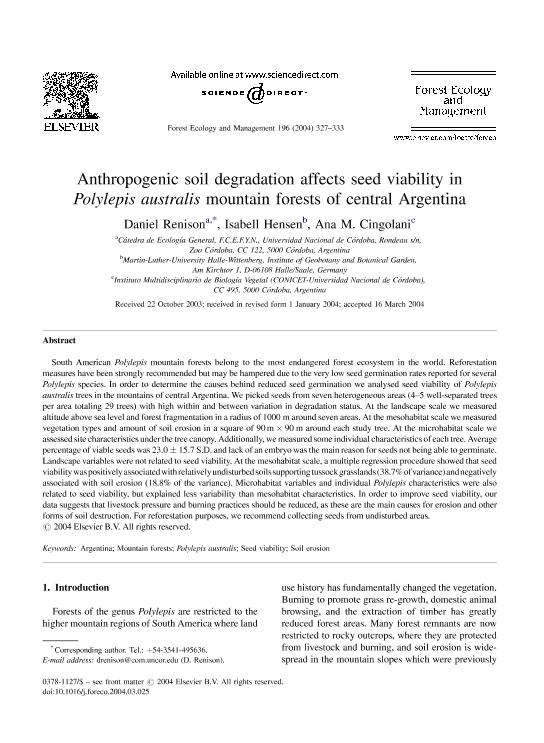Mostrar el registro sencillo del ítem
dc.contributor.author
Renison, Daniel

dc.contributor.author
Hensen, Isabell
dc.contributor.author
Cingolani, Ana María

dc.date.available
2018-04-05T18:25:46Z
dc.date.issued
2004-07
dc.identifier.citation
Renison, Daniel; Hensen, Isabell; Cingolani, Ana María; Anthropogenic soil degradation affects seed viability in Polylepis australis mountain forests of central Argentina; Elsevier Science; Forest Ecology and Management; 196; 2-3; 7-2004; 327-333
dc.identifier.issn
0378-1127
dc.identifier.uri
http://hdl.handle.net/11336/40946
dc.description.abstract
South American Polylepis mountain forests belong to the most endangered forest ecosystem in the world. Reforestation measures have been strongly recommended but may be hampered due to the very low seed germination rates reported for several Polylepis species. In order to determine the causes behind reduced seed germination we analysed seed viability of Polylepis australis trees in the mountains of central Argentina. We picked seeds from seven heterogeneous areas (4–5 well-separated trees per area totaling 29 trees) with high within and between variation in degradation status. At the landscape scale we measured altitude above sea level and forest fragmentation in a radius of 1000 m around seven areas. At the mesohabitat scale we measured vegetation types and amount of soil erosion in a square of m around each study tree. At the microhabitat scale we assessed site characteristics under the tree canopy. Additionally, we measured some individual characteristics of each tree. Average percentage of viable seeds was 23.0±15.7 S.D. and lack of an embryo was the main reason for seeds not being able to germinate. Landscape variables were not related to seed viability. At the mesohabitat scale, a multiple regression procedure showed that seed viability was positively associated with relatively undisturbed soils supporting tussock grasslands (38.7% of variance) and negatively associated with soil erosion (18.8% of the variance). Microhabitat variables and individual Polylepis characteristics were also related to seed viability, but explained less variability than mesohabitat characteristics. In order to improve seed viability, our data suggests that livestock pressure and burning practices should be reduced, as these are the main causes for erosion and other forms of soil destruction. For reforestation purposes, we recommend collecting seeds from undisturbed areas.
dc.format
application/pdf
dc.language.iso
eng
dc.publisher
Elsevier Science

dc.rights
info:eu-repo/semantics/openAccess
dc.rights.uri
https://creativecommons.org/licenses/by-nc-sa/2.5/ar/
dc.subject
Polylepis Australis
dc.subject
Soil Erosion
dc.subject
Argentina Mountain
dc.subject
Seed Viability
dc.subject.classification
Otras Ciencias Biológicas

dc.subject.classification
Ciencias Biológicas

dc.subject.classification
CIENCIAS NATURALES Y EXACTAS

dc.title
Anthropogenic soil degradation affects seed viability in Polylepis australis mountain forests of central Argentina
dc.type
info:eu-repo/semantics/article
dc.type
info:ar-repo/semantics/artículo
dc.type
info:eu-repo/semantics/publishedVersion
dc.date.updated
2018-04-03T19:20:28Z
dc.journal.volume
196
dc.journal.number
2-3
dc.journal.pagination
327-333
dc.journal.pais
Países Bajos

dc.journal.ciudad
Amsterdam
dc.description.fil
Fil: Renison, Daniel. Consejo Nacional de Investigaciones Científicas y Técnicas. Centro Científico Tecnológico Conicet - Córdoba. Instituto de Investigaciones Biológicas y Tecnológicas. Universidad Nacional de Córdoba. Facultad de Ciencias Exactas, Físicas y Naturales. Instituto de Investigaciones Biológicas y Tecnológicas; Argentina
dc.description.fil
Fil: Hensen, Isabell. Martin-Luther-University Halle-Wittenberg. Institute of Geobotany and Botanical Garden; Alemania
dc.description.fil
Fil: Cingolani, Ana María. Consejo Nacional de Investigaciones Científicas y Técnicas. Centro Científico Tecnológico Conicet - Córdoba. Instituto Multidisciplinario de Biología Vegetal. Universidad Nacional de Córdoba. Facultad de Ciencias Exactas Físicas y Naturales. Instituto Multidisciplinario de Biología Vegetal; Argentina
dc.journal.title
Forest Ecology and Management

dc.relation.alternativeid
info:eu-repo/semantics/altIdentifier/url/https://www.sciencedirect.com/science/article/pii/S037811270400221X
dc.relation.alternativeid
info:eu-repo/semantics/altIdentifier/doi/https://doi.org/10.1016/j.foreco.2004.03.025
Archivos asociados
